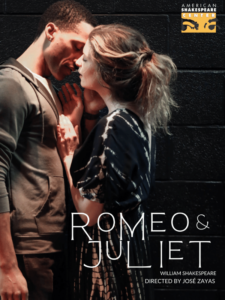“Romeo and Juliet Love Scholarship”
Opening Section
As soon as the show started, I realized I was about to see something different. No servants saying, “Do you bite your thumb at us, sir?” No “dog of the house of Montague moves me.” No Tybalt starting a brawl. The actor finished speaking the prologue, and then the cast just began fighting. This was not at all what I have come to expect from the American Shakespeare Center’s productions of Early Modern work, which tend toward preciousness, especially as it concerns language. The ASC brand has been set for nearly two decades: productions behave according to set patterns. The actors double and triple the roles they play, often to hilarious comic effect; the shows are produced – as their slogan has it – with the lights on, in their Staunton, Virginia replica of the Blackfriars Theatre; costumes are modern, as though the show is taking place in a space without time, or rather as though the show is taking place in a theatre in the present; and there’s a fairly strict policy against cutting characters. An ASC show usually does not display a strong directorial hand; the words and the actors are understood as of primary importance here. In fact, some shows are produced without directors at all (they have branded this the “Actors’ Renaissance Season,” and the stated idea is that actors are working to stage the shows themselves, allegedly as they would have during the Early Modern period).
José Zayas’s production of Romeo and Juliet for the American Shakespeare Center’s Spring 2022 season broke nearly all of these usual patterns. Lines that are almost always cut in productions of R&J – in which the lovers ruminate on death, in which they talk to Friar Laurence about suicide, in which they think, in short, about their own doom – were emphasized in this production. Although R&J is a play whom most would typically say is focused on young love fighting against all odds and against the norms of the family and the state, Zayas’s production seemed focused on mortality, emphasizing from the very beginning the young hero and heroine’s love affair(s) with death rather than their love for one another. Zayas asked us – from the very beginning of his production – to focus on “the fearful passage of their death-marked love” more than anything else.
Romeo and Juliet talk about suicide and death a great deal in the play – both when they are together and when they are apart. This is a rather simple fact that I first noticed only after it was pointed out in a short essay by Carla Freccero titled “Romeo and Juliet Love Death” in the 2011 volume Shakesqueer. But despite the numerous productions of R&J I’ve seen in my life, I had never given the death drive much thought. The longer I watched Zayas’s Romeo and Juliet at the ASC, however, the more astonished I became. Zayas had directed R&J as a deep meditation not on love but on mortality, on the disaffection of young people and their refusal to live in a world whose promises are hollow. It was almost as if Zayas had staged Freccero’s essay, experimenting with Shakespeare’s play enough to help the audience see what “Romeo and Juliet Love Death” had argued.
This is, in fact, precisely what had happened. In conversation with the actor who played Mercutio after the show, I learned that Zayas had been inspired by “Romeo and Juliet Love Death” and that the director had used the essay to help him think through the important aspects of the text as he staged it. Zayas’s Romeo and Juliet production, which reinvigorated this Early Modern text, is a superb example of the value of scholarship for production and a call to action for scholars. Zayas didn’t use Freccero’s essay as a collection of data to help him understand the meanings of particular words or to help him with pronunciation or meter. He consulted with the essay as inspiration, as a way to develop a novel approach to a play we all (think we) know very well.
Taking Zayas’s Romeo and Juliet – and the new leadership of the ASC – as a case study, this essay argues that directors need scholarship that focuses on novel interpretations of early modern plays. What is so extraordinary about this Romeo and Juliet is that the ASC has, for decades, been operating from the perspective of getting back to original practices. This production, to the contrary, found the catastrophe at the center of Romeo and Juliet by looking to an innovative queer reading of the play. What Zayas’s work demonstrates is that scholarship that rereads early modern texts can be inspiring for producers and directors, and it is absolutely necessary for a new generation of interpreters of Shakespeare and other Early Modern writers.



